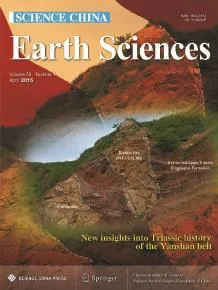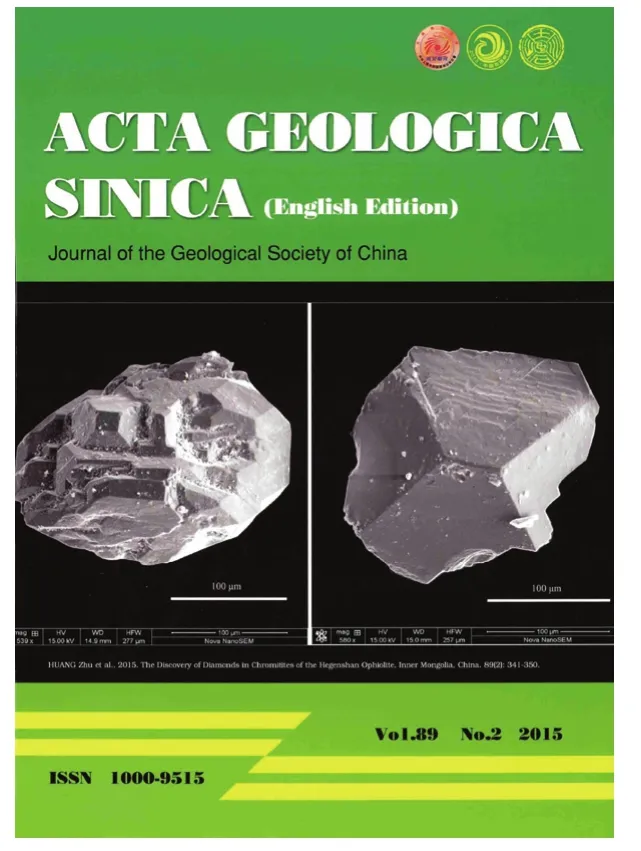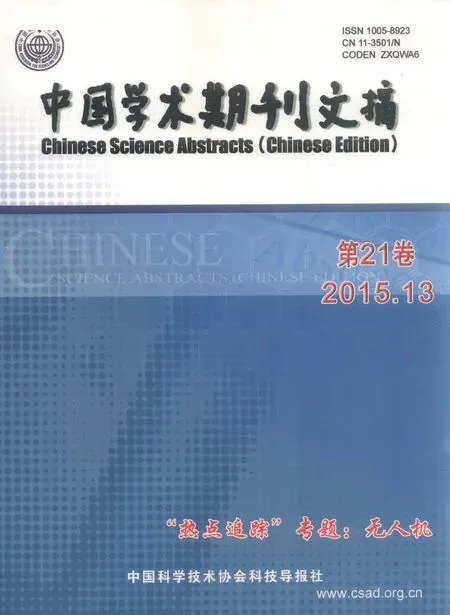地质学
2015-10-31
地质学

封面介绍:Triassic successions in the Yanshan belt consist of alluvial,fluvial and lacustrine facies deposited in rift basins. The Yanshanian orogeny led to strong deformation of Triassic-Lower Jurassic strata during the Middle Jurassic,as constrained by the 161 Ma dioritic dikes cutting through the overturned Dingjiagou Formation. For details see the research paper by WEI Honghong et al. on pages 491-501.
Revisiting Triassic stratigraphy of the Yanshan belt
WEI Honghong,WU Guoli,DUAN Liang
来源出版物:Acta Geologica Sinica(English Edition),2015,89(2): 341-350联系邮箱:YANG Jingsui,yangjsui@163.com
Age determinations of the Triassic lithostratigraphic units of the Yanshan belt were previously based on plant fossils and regional correlations of lithologies. The Liujiagou and Heshanggou Formations were assigned as the Lower Triassic,and the Ermaying Formation was regarded as the Middle Triassic. We carried out a geochronologic study of detrital zircon grains from the Triassic sandstone in the Xiabancheng and Yingzi basins in northern Hebei where the Triassic strata are exceptionally well preserved. The results show that the Liujiagou,Heshanggou,and Ermaying Formations are all Late Triassic in age. The ages of detrital zircons also revealed that the upper part of the Shihezi Formation and the overlying Sunjiagou Formation,both of which were thought to be the Middle-Late Permian units,are actually late Early to Middle Triassic deposits. This study combines the upper Shihezi and Sunjiagou Formations into a single unit termed as the Yingzi Formation. We also substitute the widely-used Liujiagou,Heshanggou,and Ermaying Formations with the Dingjiagou,Xiabancheng,and Huzhangzi Formations,respectively. Field observations and facies analysis show that the top of the Shihezi Formation is an erosive surface,marking a parallel unconformity between the Middle Permian and Lower Triassic. The Yingzi Formation is composed mainly of meandering river deposits,indicative of tectonic quiescence and low-relief landform in the Early to Middle Triassic. In contrast,the Dingjiagou,Xiabancheng,and Huzhangzi Formations are interpreted as the deposits of sandy/gravelly braided rivers,alluvial fans,fan deltas,and deep lakes in association with volcanism,thus indicating an intense rifting setting. A new Triassic lithostratigraphic division is proposed according to age constraints and facies analysis,and the results are of significance for understanding the early Mesozoic tectonic evolution of the Yanshan belt.
Yanshan belt; Triassic; detrital zircon; LA-MC-ICPMS dating; sedimentation
来源出版物:SCIENCE CHINA Earth Sciences,2015,58(4): 491-501联系邮箱:WEI HongHong,weihh@itpcas.ac.cn

The Discovery of Diamonds in Chromitites of the Hegenshan Ophiolite,Inner Mongolia,China
HUANG Zhu,YANG Jingsui,Paul T. ROBINSON,et al.
Diamond,moissanite and a variety of other minerals,similar to those reported from ophiolites in Tibet and northern Russia,have recently been discovered in chromitites of the Hegenshan ophiolite of the Central Asian Orogenic Belt,north China. The chromitites are small,podiform and vein-like bodies hosted in dunite,clinopyroxene-bearing peridotite,troctolite and gabbro. All of the analysed chromite grains are relatively Al-rich,with Cr# [100Cr/(Cr+Al)] of about 47-53. Preliminary studies of mainly disseminated chromitite from ore body No. 3756 have identified more than 30 mineral species in addition to diamond and moissanite. These include oxides(mostly hematite,magnetite,rutile,anatase,cassiterite,and quartz),sulfides(pyrite,marcasite and others),silicates(magnesian olivine,enstatite,augite,diopside,uvarovite,pyrope,orthoclase,zircon,sphene,vesuvianite,chlorite and serpentine)and others(e.g.,calcite,monazite,glauberite,iowaite and a range of metallic alloys). This study demonstrates that diamond,moissanite and other exotic minerals can occur in high-Al,as well as high-Cr chromites,and significantly extends the geographic and age range of known diamond-bearing ophiolites.
diamond; moissanite; deep mantle minerals; chromitites; Hegenshan ophiolite; Inner Mongolia
